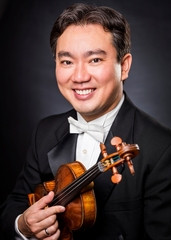|
Back
The Fiddler As Meryl Streep New York
David Geffen Hall, Lincoln Center
09/25/2015 - & September 26, 2015
Esa-Pekka Salonen: LA Variations
Richard Strauss: Ein Heldenleben, opus 40
Frank Huang (Violin), New York Philharmonic Orchestra, Alan Gilbert (Music Director/Conductor)

E.-P. Salonen (© Katja Tähjä)
Two non-musical revelations last night for one of the “official’ opening nights of the New York Philharmonic.
First, that the new Philharmonic composer-in-residence, Esa-Pekka Salonen is not your traditionally diffident, impassive artist, pleading that the music speaks for him. No, Mr. Salonen is voluble, entertaining, informative (he offered a Groves Encyclopedia explanation to his music), personal…and probably would have spoken for the entire evening. Except that the New York Philharmonic Orchestra was getting paid to play.
Second, that the new Beijing-born Juilliard-educated Concertmaster, Frank Huang, proved that he is more than a fine violinist. He has the versatility and dramatic chops of a seasoned actor.
More on that later. It was Mr. Salonen’s LA Variations, a belated New York premiere. Written 20 years ago, during a sabbatical from his beloved first American orchestra, LA Variations is not poor French grammar (no, it isn’t Les Variations), but a tribute to the Los Angeles Philharmonic Orchestra. And in that sense, rather than “variations”, this is a 20-minute Concerto For Orchestra.
And a huge orchestra as well. A whole thesaurus of percussion (log drums, bongos, tubular bells, tam-tams and tom-toms etc), great brasses, winds, even an electronic sampler.
And like his verbal explanation before, Mr. Salonen was never averse to using his masses forces to their nth degree. Many Finnish composer play nominal homage to Jean Sibelius, but Mr. Salonen had no hesitation in paying blatant brassy tribute, even though the names he uses–”Big Machine”, “Big Chord”–have an almost infantile straightness.
The music is equally direct–in a directly opaque manner. That is, each variation is terrific in itself. We have those “big machine” chords. And we have sections that are almost funny: high woodwinds followed by basses and bass trombones in the lowest register, and a double-bass solo. Even folk music. And canons, and drums pounding in different South American rhythms. A chorale or two.
And an ending with a humorous piccolo solo.
The work, as Mr. Salonen announced beforehand, is a work of “joy”. Joy in the Los Angeles Philharmonic, with living in that city (Helsinki is awfully nice, quaint, charming...dull) and joy that he felt balancing out conducting and composing genius. In this “transparent’ playing, we Stravinsky color Ligeti humor, the lushness of Debussy and Lutoslawski.
At the same time, Mr. Salonen was not loath to frame the work on two chords encompassing the 12 tones, with variations that strayed –but never departed from–what Mr. Salonen called “the DNA” factor of the great tone row.
That, though, was for the analysts. One didn’t need the organic cohesion to enjoy the soaring streams of notes, the punchy punctuations, the snake-like crawls of sounds intertwining amongst themselves, the pure muscularity of a mind which equilibrates intellect and playfulness, brassy brawniness with a Baroque gracefulness.
One can only hope that Mr. Salonen builds on LA Variations with a NY Variations over the year he has with our own orchestra.
An equally muscular work followed the intermission, this obviously far more familiar–and anything but opaque. A kind of Donald Trump with brains, Strauss called himself a hero, portrayed his whole hero’s life including his own music, his hatred of critics, his love, his war (though Strauss never fought), even his own death and transfiguration, going to heaven.
Fortunately, for all its brash, even vulgar program, A Hero’s Life has sufficient special effects, eccentric tricks and ersatz spirituality. Since conductor Alan Gilbert relishes these big palettes, the NY Phil should have handled the colors with equanimity. Last night, sadly, the solos were fine, but the orchestra itself seemed mired in its own sounds. Mr. Gilbert urged his troops onward, but their movements were less army on parade than a regiment battling through mud.

F. Huang (© Chris Lee)
Still, if the war and the heroes’ “adversaries” were less than convincing, Concertmaster Frank Huang painted a picture of Strauss’s wife as she was, warts and all.
It must be madness for a violinist to switch from being part of the ensemble to suddenly a) do a whole solo violin-concerto movement; and b) to turn a fiddle into a woman. Especially a woman like Pauline Strauss.
In my score, Strauss paints directions which are anything but musical. Mr. Huang had to play with “cockiness”, “sentimentality”, “commanding”, “as a flirt”, giggling, angry and even with a “hypocritical” flavor.
That sounded like a job for a Meryl Streep. But Frank Huang, beginning with a deceivingly sweet dulet passage, managed to paint Pauline Strauss with the most minute brushstrokes. I don’t know how others took it, but to these ears, Mr. Huang showed an almost unfathomable unpredictability.
In his later operas, those equally complex ladies were helped along with wonderful librettos. Mr. Huang, the evident centerpiece of this performance, was like Gloria Swanson’s line from Sunset Boulevard:
“For this music, we don’t need words. We have a fiddler.”
Harry Rolnick
|